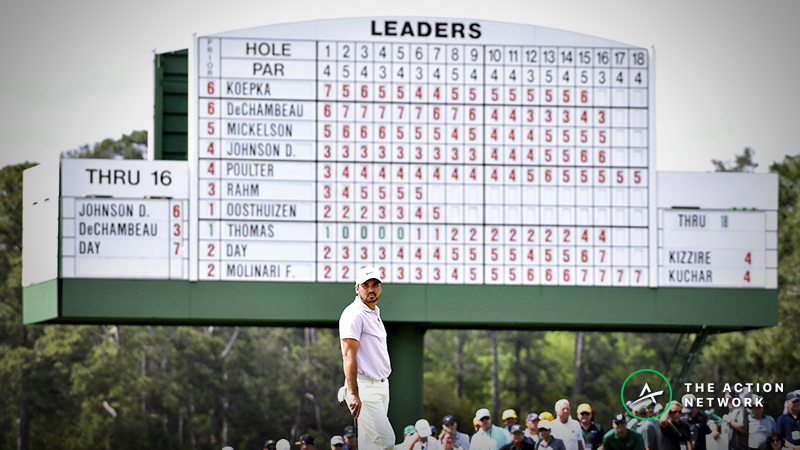
Michael Madrid, USA Today Sports. Pictured: Jason Day
First-Round Leader Bets in Golf
| Click a section to jump ahead. | |
| 1. What is a First-Round Leader bet? | |
| 2. Why do FRLs offer value? | |
| 3. What makes a good FRL bet? | |
| 4. Other factors to consider | |
| 5. Rules & Ties | |
The rise in popularity of golf betting has led to an increased awareness of the “First-Round Leader” market, but it’s still far more niche than it should be.
I have been wagering on First-Round Leaders — or FRLs as they’re known in Golf Twitter circles — for four years. In my opinion, no market in sports betting presents the opportunity to consistently win a 100-1+ future quite like this one.
Gamblers will wait 4-6 months for the chance to cash a 10-1 futures ticket in the NFL or NBA, while 100-1 longshots like Rory Sabbatini routinely come through after just one round of golf.
Let’s run through this FAQ style to highlight why this is a market that should be on your radar.
We’ll detail it more below, but most sportsbooks will chop your first-round leader bets in the event of a tie — if Hideki Matsuyama went off at 45-1 to lead after Round 1 and finishes in a three-way tie for first, you’re paid out at 15-1.
What is a First-Round Leader bet?
It’s a simple question, but let’s answer it anyway. A FRL bet is a wager placed on a golfer to be in first place after Round 1 of a given golf tournament.
Why do FRLs offer consistent betting value?
FRL odds are directly correlated with outright winner odds, but that doesn’t make much sense: We know that closing out a 72-hole PGA Tour tournament is one of the hardest things to do in all of sports, and involves a far different skill set than going low for one round.
If you follow golf long enough or keep record of Round 1 scoring performance, you will notice specific trends around certain players. Some guys struggle out of the gates, while others are prone to starting fast.
The market typically doesn’t adjust for these variables.
What’s the profile of a good FRL bet?
Joel Dahmen, a 31-year-old journeyman who’s little-known outside of golf circles, is the perfect example. He’s been printing money for his FRL backers this year, as he held his third FRL lead/co-lead of the season this past week at Quail Hollow.
Dahmen was priced anywhere from 80-1 to 100-1 odds and shared the lead Thursday overnight lead with Rory McIlroy.
He joins the likes of other FRL longshot standouts over the years: Abraham Ancer, Sam Saunders, Tony Finau, Matt Every, Keith Mitchell and Aaron Wise. The latter two were Thursday machines to start their careers before they each eventually broke through on Sundays.
What are the factors I should be looking for?
Perhaps the two most important parts of any good FRL handicap are the weather and the course conditions.
The weather draw can eliminate half of the field in extreme circumstances. For example, if the wind is gusting for the afternoon wave, that’s a good reason to focus solely on the morning pairings. Same goes for rain, which can soften greens and make playing conditions easier for the players who get to attack the course in the aftermath.
 Weather plays a huge role in first-round leader handicapping. Credit: Rob Schumacher, USA Today Sports.
Weather plays a huge role in first-round leader handicapping. Credit: Rob Schumacher, USA Today Sports.Another subtle weather tidbit: In certain parts of the country, temperatures can swing from the 50s in the morning to the 70s and 80s in the afternoon. The hotter the temperature, the farther the ball will typically travel, giving afternoon players in this example an advantage.
In terms of course conditions, poa greens will skew a heavy morning wave FRL bias because of how quickly that type of grass grows throughout the day, giving golfers playing in the afternoon a bumpier surface to putt on.
Again, because the FRL odds are directly correlated with a player’s chances of winning, you can find a rather large edge over oddsmakers, who do not always account for any of these factors.
FRL rules, and how ties are handled
As with all types of prop betting, you want to make sure to check your sportsbook’s rules before placing a wager. In the case of FRLs, most books stick to the “dead heat rule” if there’s a tie, meaning the odds are divided by how many players tied for the lead.
Using the earlier Dahmen example from this past week: If you wagered $100 on him at 80-1, your payout after he tied with Rory would have been $4,000 — the original payout ($8,000) divided by the total number of players to tie for the lead (two, in this case).
I have seen some sportsbooks that will grade such ties as No Action, meaning the original bet is refunded but none of the winnings are paid out (even partially). FRLs are not worth a wager if this is how your book grades them, as so many Thursdays end with a tie at the top.

